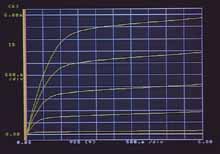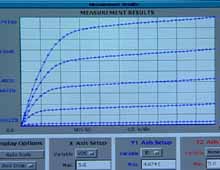 Current-voltage characteristics of MOSFET as obtained in the screen of the HP4155B in Prof. del Alamo's laboratory. |
In this first demonstration, two different homeworks using the setup were required of the students. In the first one, a Schottky diode was characterized. In the second one, a detailed characterization of a MOSFET (metal-oxide-semiconductor field-effect transistor) was carried out. In both cases, a number of different measurements were to be taken on the devices and the data was to be downloaded for further local processing and graphing using MATLAB or EXCEL. This typically took the form of calculating several figures of merit, extracting device parameters and comparing with theoretical models discussed in class.
In the Spring semester of 1999, Prof. del Alamo used an improved version of the system in 6.012 Electronic Devices and Circuits, a large junior-level subject in EECS. About 85
 Current-voltage characteristics of MOSFET as graphed on the screen of the remote user. |
In both field trials, surveys of the students were carried out. Selected comments from the 6.012 trial follow:
- "I thought this was a very useful experience. Itís often tough to go through a course like this where we deal with such microscopic elements and not be able to see any real data. This problem set allowed us to get some real data and do some real calculations on it."
- "I liked being able to work on this from the leisure of my room. I normally donít have time during the day to work on lab assignments and thus find myself going to labs late at night when being in the laboratory is the most unpleasant. Being able to sit at my computer and work on the problem made me much more apt to actually thinking about what was going on instead of just trying to get results so I could go home."
The field trials have revealed that the system concept is sound, that the experience is educationally meaningful, and that the system scales well to subjects with large numbers of students. Several problems have also been identified. In the 6.012 homework, the device blew up under very heavy use in the middle of the last night before the homework was due. This left a number of stranded students that could not finish the homework on time. The donation of a switching matrix from HP will solve this problem because it will allow several devices to be accessible at any one time. A second problem was the need of a better manual. A further problem that was identified was the lack of experience of students in handling "real" data. As a result, the data manipulation part of the homework in 6.012 ended up taking far too much time. The use of this system requires that we coach students better on how to process and graph experimental data.
For more information, contact: Prof. Jesus del Alamo
Copyright © 1999 Massachusetts Institute of Technology